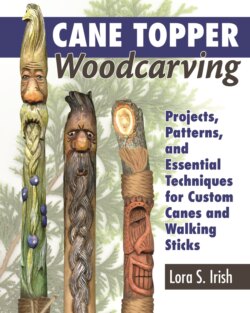Читать книгу Cane Topper Woodcarving - Lora S. Irish - Страница 28
На сайте Литреса книга снята с продажи.
Preparing a Staff
ОглавлениеHere are five different ways you can prepare a staff. Whether you peel the bark, partially peel the bark, or leave the bark on the stick, all preparation methods will eventually be treated the same when it comes time to use either an oil finish or paste wax finish.
With bark: Leaving the bark on your staff emphasizes the fact that your stick is created from a natural, cut tree. For heavily textured barks, plan for the grip area of the stick to fall on the cane topper instead of the staff itself.
Without bark: It is easy to peel the bark from a freshly cut stick by using a bench knife to loosen a small area of the bark at the top of the stick, then pulling and peeling it away from the wood.
Partially debarked: You can peel the bark off a dried stick in the same manner, but often the bark will come off in much smaller pieces, and some areas may not be completely removed. This can leave the staff with several color tones throughout its surface.
Twist cut bark: While the staff is fresh cut, use a bench knife to peel a spiral strip around the outside of the staff. This creates a spiral of bark twining around the peeled wood section. I often use this type of peeling on smooth-barked woods such as maple or elm.
Sanded bark: Rough-textured barks such as black walnut, hickory, and oak can be sanded after the stick is dry. This leaves the bark on the stick while removing the extra-coarse areas of the bark.
